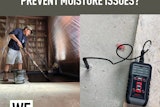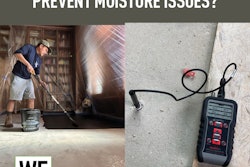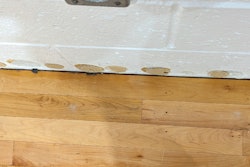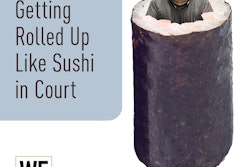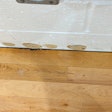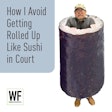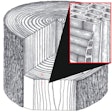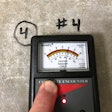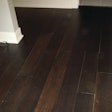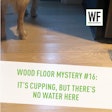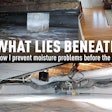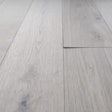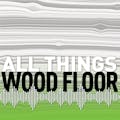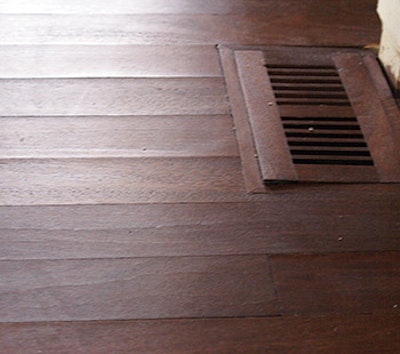
In my wood floor inspection experience, about 90 percent of the claims I go on are moisture-related, whether the floors are cupping or gapping or something else. Often what I see is that the contractor immediately wants to blame the manufacturer, and it's convenient for everybody else involved to point the finger at the contractor. The truth is that the vast majority of those floors never would have had any problems at all if everybody were educated through the process, from the person selling the floor to the homeowner living with it. In this article I'll highlight some of the main missteps I see contractors take and what they are obligated to do under our industry standards.
Following Directions
Before you step foot on a job, you should know what the directions from the manufacturer are and what the National Wood Flooring Association's Installation Guidelines say. Manufacturers' directions always take precedence over any other instructions or guidelines, and many problems I see could have been avoided if people would have just followed directions.
Many times when I go to see failed jobs, the wood flooring contractors will tell me that the NWFA Guidelines don't apply to them because they aren't members of the NWFA. They couldn't be more wrong. In the eyes of the law, the NWFA's Installation Guidelines are the industry standards for best practices, regardless of whether someone is a member of the association or not. (For gym floors, the Maple Flooring Manufacturers Association guidelines are the standards used.) In this article I'll be quoting parts of the Guidelines that frequently come up in court. Do you know what the Guidelines say? You should if you want to protect your wood flooring business.
Under Control
As a contractor, what can you control? You can control the job-site conditions when your wood flooring is at the job. If you can't control your job-site conditions, then your flooring shouldn't be at the job. This brings us to our first quote from NWFA's Installation Guidelines:
"Do not deliver flooring to the job site or install wood flooring until appropriate temperature and humidity conditions have been achieved."
 Just using a hygrometer is not enough-you need to make sure it's correct. Here a hygrometer that was left on the job site shows a substantially different reading than the properly calibrated hygrometer on the left. (Photo courtesy of Roy Reichow)
Just using a hygrometer is not enough-you need to make sure it's correct. Here a hygrometer that was left on the job site shows a substantially different reading than the properly calibrated hygrometer on the left. (Photo courtesy of Roy Reichow)
Of course, appropriate temperature and humidity conditions vary depending on your geographic location, the season, and what sort of controls will be in place (or won't be in place) long-term. Guidelines dictate that wood flooring not be delivered until the HVAC system in the home is in operation. Before you even measure the moisture, go down to check the mechanicals; see what the home has in place and whether they are operating properly. In a remodeling application, take a look around the home at the other woodwork such as mitered joints on window trim, moldings and panel inserts on cupboard doors. They can all help indicate what the moisture conditions are like in the home.
These days some contractors have started putting hygrometers at their jobs and periodically checking them to see if the job-site conditions are acceptable for installation yet or not. (There are also remote systems you can use to monitor job-site conditions.) A handy feature many people don't even know about on hygrometers is the "lowest reading" and "highest reading" functions-it will tell you the highs and lows for a certain period of time.
Make sure you have a conversation with the homeowners about how well they control the humidity in their homes and how that will affect the floors. Although you may like every customer to leave the air conditioning on 24/7 during high-humidity months, they may enjoy the lake breezes coming right through the house. That's their prerogative, but they have to know what that will do to their wood floors. (And you have to know if that will work with the flooring they have picked. Some products just won't work with humidity swings that are too big or RH that gets too low.)
This is a good time to bring up the old cliché that "a picture is worth a thousand words." Start taking photos of all your measurements on the job site. Now that we all have cameras on our phones, it is easier than ever to create a photographic trail of your diligence measuring every kind of moisture on the job.
The Moisture Check
Once you've determined that conditions are acceptable (and taken photos of your readings), the wood can arrive at the job. Here we come to another quote from Installation Guidelines:
"Upon delivery, check wood flooring moisture content with a moisture meter to establish a baseline for acclimation. Check the moisture content of multiple boards. A good representative sample is typically 40 boards for every 1,000 square feet of flooring."
And this is what the Guidelines say about subfloor moisture testing:
"Test for moisture at several locations in the room-a minimum of 20 per 1,000 square feet-and average the results."
 With cameras on every phone, it's easier than ever to take photos of the job site. Write the name of the job, the date and the results on the subfloor, and take photos of your readings. (Photo by Scott Taylor)
With cameras on every phone, it's easier than ever to take photos of the job site. Write the name of the job, the date and the results on the subfloor, and take photos of your readings. (Photo by Scott Taylor)
This is a problem. Why? A friend of mine who works at a distributor (in a region with huge seasonal moisture swings, no less) estimates that about 80 percent of his contractors still don't own moisture meters. Some guys think they have been doing floors long enough that they can go without. One time in court-I am not making this up-I even heard a wood flooring "expert witness" tell the judge he didn't need a moisture meter because he could tell if the wood was too wet by pressing his hand on the flooring.
The truth is that, no matter how long they have been in business, nobody can tell what the moisture content of a subfloor or a wood floor is without a moisture meter. And, just using a moisture meter isn't enough. You need to follow the directions, adjust for the species and make sure the meter is calibrated correctly. I had an inspection at a big commercial job once where the building owner was trying to blame the wood flooring contractor for the failing floor. My measurements had shown that the owner had let the job site get too dry, and the owner's expert had a psychrometer and moisture meter giving him substantially different readings. I asked him when was the last time he had calibrated his psychrometer, and he said he didn't. I asked him if he adjusted his moisture meter reading for red oak, and he said his meter had a "hardwood" setting.
The point being, just taking measurements is not enough. You are a professional, so use professional equipment. Take your readings correctly and, for the purposes of Guidelines, take the number suggested per every 1,000 square feet. As you're taking them, write the job name and date right on the subfloor and take some photos.
Still Waiting for the Install
 This homeowner said that Aprilaire humidification systems were in place on both furnaces in the home, but a quick check revealed that the filters were dry and there was no water in the drain hoses. (Photo by Scott Taylor)
This homeowner said that Aprilaire humidification systems were in place on both furnaces in the home, but a quick check revealed that the filters were dry and there was no water in the drain hoses. (Photo by Scott Taylor)
Can you install the flooring yet? If we are following Guidelines, that would depend on this statement:
"Prior to installation, ensure that wood flooring is within acceptable range of moisture content with the wood subfloor. For solid strip flooring (less than 3" wide), there should be no more than 4 percent moisture content difference between properly acclimated wood flooring and subflooring materials. For wide-width solid flooring (3" or wider), there should be no more than 2 percent difference in moisture content between properly acclimated wood flooring and subflooring materials."
If the moisture is off enough to cause a problem on the job and you have inaccurate moisture meter readings, that could lead you to make a terrible mistake. Or, if your readings are correct but not within that acceptable range and you decide to install anyway, you could be liable for that job.
The moment you decide to start installing the flooring is a big step. Installation Guidelines say:
 Photos by Scott Taylor
Photos by Scott Taylor
"Installation constitutes acceptance of flooring material, subfloor/substrate, the job site itself, including ambient temperature and relative humidity at the time of installation, and all impacting variables that may affect a wood floor."
In other words, in many cases, once you decide to go ahead and start installing that wood floor, you've bitten off a big chunk of liability if something goes wrong.
The Dreaded Inspection
If you end up having a failed job-or, at least, one the customer thinks is a failed job-cooperate with the inspector. Telling the inspector you don't want to answer any questions makes you look like you may be hiding something. Provide all your documentation and answer the questions honestly. Understand that most inspectors are not out to get you. In fact, the worst part of my job is finding that the wood flooring contractor made a mistake, and it's a costly one. I've had contractors pull me aside before an inspection and tell me that if my findings go against them, they will lose their business. All I can do is hope my objective findings are in their favor.
Once contractors understand that the homeowner has some responsibility, e.g., maintaining a consistent environment, they soon realize how important the role of an inspector can be. Remember that you can also hire your own inspector. Don't be afraid to ask questions when you're shopping for an inspector. Ask about their experience, how much they charge, and how long it will take after the inspection until you receive the report. Don't be afraid to ask for a previous inspection report that is similar to the one you are asking for from this inspector. Know that a thorough inspector should spend many hours on research for every hour he or she spends on the job site during the inspection. They should talk to every person involved with the job in any way and fact-check what they are told in every way possible.
 Problems can arise when the homeowners are uneducated about maintenance. This family told me they 'take great care of the their floor.' I took this photo as I began my inspection. (Photo by Scott Taylor)
Problems can arise when the homeowners are uneducated about maintenance. This family told me they 'take great care of the their floor.' I took this photo as I began my inspection. (Photo by Scott Taylor)
Plain and Simple
As I said earlier, with more education at all levels of the industry, there should rarely be a reason for an inspector to have to go on a moisture-related claim. Plain and simple, wood is hygroscopic, and if you allow the wood to sit on a job site where the temperature and humidity are allowed to change enough, then the flooring will change dimension. If the job site has a high relative humidity, the flooring will swell, and if the job site is too dry, the flooring will shrink. When this is unexpected for anyone involved, from the contractor to the homeowner, the potential builds for a future inspection. Take the steps you can on every job to make sure you prevent claims and can defend yourself in the event that an inspection happens.










